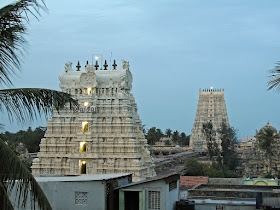Ramanathaswamy Temple, Rameswaram
Ramanathaswamy Temple is a Hindu
temple dedicated to god Shiva located on Rameswaram
island in the state
of Tamilnadu, India. It is also one of the twelve Jyothirlinga temples, where Shiva is worshipped in the form of
a Jyotirlingam (English: pillar of light). It is one of the 274 Paadal Petra Sthalams, where the three of the most revered Nayanars (Saivite saints), Appar, Sundarar and Tirugnana
Sambandar, have glorified the
temple with their songs.
The temple was expanded during the 12th century by Pandya
Dynasty, and their principal
shrines sanctums were renovated by Jeyaveera Cinkaiariyan and his successor
Gunaveera Cinkaiariyan of the Jaffna
kingdom. The temple has the
longest corridor among all Hindu temples in India. The temple is
considered a holy pilgrimage site for Shaivites, Vaishnavites and Smarthas. It is connected to the Indian mainland at Mandapam by
the Indira Gandhi Bridge.
It is dedicated to Lord Shiva and has been built over
the spot where Lord Rama (the reincarnation of Lord Vishnu) worshipped a Linga
(the representation of Shiva) molded from sand. This temple is a symbol of the
synergy that exists in the two distinct streams of worship of Shaivism and
Vaishnavism. Ramanathaswamy Temple is distinguished by the largest mandapam
(hall) anywhere in India.
Rameswaram is part of the rites of passage rituals that
are performed by Hindus for ancestors. This is the 252nd Devaram
Paadal Petra Shiva Sthalam and 8th Sthalam of Pandya Nadu. Moovar has sung
hymns in praise of Lord Shiva of this temple.
This Shivastalam is considered to be one of the
holiest shrines in India. It represents the southernmost of the 12 Jyotirlingams of India and has been a time honored pilgrimage
center held on par with Banaras. The island-temple town is located off of the Sethu
coast of Tamilnadu (south eastern).
This temple is associated closely with the Ramayana and
Rama's victorious return from Sri Lanka. Rameswaram is an interesting temple
both from the standpoint of its association with Rama and from a structural
standpoint. A. huge temple in the island of Rameswaram (reached via the Pamban Bridge
across the sea), Rameswaram is known for its long ornate corridors and towers
and 36 Theerthams.
A Pilgrimage to Rameshwaram is among the important
injunctions laid on the Hindu from time immemorial. The great temple of
Sri Ramanatha is connected by tradition with Kasi. A pilgrimage to Kasi is
not considered complete without a pilgrimage to Rameshwaram. In olden days
groups of pilgrims, many of them quite old, walked huge distances to the two
temples, taking months and years, and some failing to survive the dangers of
such incredibly long journeys.
The Rameshwaram pilgrimage has long been a tradition in
South India, particularly in Tamilnadu, and has passed into folklore. Many
kings of old prided themselves on having planted columns of victory in
Rameshwaram – Krishna III the Rashtrakuta, in the 10th century the Hoysala,
Vishnuvardhan, in the 12th century.
Legends
For brief details, please refer below link;
History
For brief details, please refer below link;
The Temple
For brief details, please refer below link;
Temple Layout
For brief details, please refer below link;
Theerthams
There are sixty four Theerthams (holy water bodies) in
and around the island of Rameswaram, Tamilnadu, India. According to Skanda
Purana, twenty-four of them are
important. Bathing in these Tirthams is a major aspect of the pilgrimage to
Rameswaram and is considered equivalent to penance. Twenty two of the
Tirthams are within the Ramanathaswamy Temple. The number 22 indicates the 22 arrows in Rama's
quiver. The first and major one is called Agni Theertham, the sea (Bay
of Bengal).
Theerthams Inside Temple:
For brief details, please refer below link;
Theerthams Outside Temple:
For brief details, please refer below link;
Pooja Timings
For brief details, please refer below link;
Religious Significance
For brief details, please refer below link;
Festivals
For brief details, please refer below link;
Accommodation Facilities
For brief details, please refer below link;
Tips
To carry Mobile phones, IPods, Ipads, Cameras (Still,
Video etc.,), Storage Devices, Suit case, Luggage Bags, matchbox, Sharp pointy
objects, and Flammable materials inside the Temple premises are prohibited. Don’t
wear too much of jewels and stand in the queue. Worshiping God with Wet Cloths
is prohibited. Entering Temple Premises with wearing Lungi is prohibited.
Contact Details
For brief details, please refer below link;
Connectivity
For brief details, please refer below link;








































